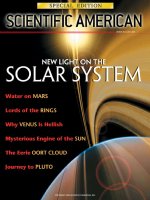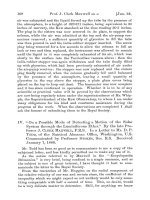the formation of the solar system theories old and new
Bạn đang xem bản rút gọn của tài liệu. Xem và tải ngay bản đầy đủ của tài liệu tại đây (12.04 MB, 340 trang )
P512tp.indd 1 9/28/07 9:57:44 AM
The Formation of
The Solar System
Theories Old and New
This page intentionally left blankThis page intentionally left blank
Imperial College Press
ICP
Michael Woolfson
University of York, UK
P512tp.indd 2 9/28/07 9:57:47 AM
The Formation of
The Solar System
Theories Old and New
British Library Cataloguing-in-Publication Data
A catalogue record for this book is available from the British Library.
Published by
Imperial College Press
57 Shelton Street
Covent Garden
London WC2H 9HE
Distributed by
World Scientific Publishing Co. Pte. Ltd.
5 Toh Tuck Link, Singapore 596224
USA office: 27 Warren Street, Suite 401-402, Hackensack, NJ 07601
UK office: 57 Shelton Street, Covent Garden, London WC2H 9HE
Printed in Singapore.
For photocopying of material in this volume, please pay a copying fee through the Copyright
Clearance Center, Inc., 222 Rosewood Drive, Danvers, MA 01923, USA. In this case permission to
photocopy is not required from the publisher.
ISBN-13 978-1-86094-824-4
ISBN-10 1-86094-824-3
All rights reserved. This book, or parts thereof, may not be reproduced in any form or by any means,
electronic or mechanical, including photocopying, recording or any information storage and retrieval
system now known or to be invented, without written permission from the Publisher.
Copyright © 2007 by Imperial College Press
THE FORMATION OF THE SOLAR SYSTEM
Theories Old and New
Alvin - The Formation of the.pmd 11/22/2007, 6:35 PM1
August 30, 2007 10:19 spi-b525 The Formation of the Solar System 9in x 6in f m FA1
Contents
Introduction xv
Prologue: The Dreamer xxi
General Background
Chapter 1. Theories Come and Theories Go 3
1.1 What is Science? 3
1.2 The Problem of Cosmogony 5
1.3 New Theories for Old 7
Chapter 2. Measuring Atoms and the Universe 9
2.1 Measuring Things in Everyday Life 9
2.2 Science and Everyday Life 11
2.3 Small Things Beyond Our Ken 11
2.4 Measuring Things in the Solar System 13
2.5 Large Things Beyond Our Ken 15
Enlightenment
Chapter 3. Greek Offerings 19
3.1 Even Before the Ancient Greeks 19
3.2 Plato and Aristotle 20
3.3 Aristarchus — A Man Ahead of his Time 21
v
August 30, 2007 10:19 spi-b525 The Formation of the Solar System 9in x 6in f m FA1
The Formation of the Solar System
3.4 Eratosthenes — The Man who Measured the Earth 22
3.5 Ptolemy and the Geocentric Solar System 24
Chapter 4. The Shoulders of Giants 27
4.1 The Refugees 27
4.2 Nicolaus Copernicus and a Heliocentric Solar System 28
4.3 Tycho Brahe — the Man with a Golden Nose 30
4.4 Johannes Kepler — A Mathematical Genius 32
4.5 Galileo Galilei — Observation versus Faith 34
4.6 Isaac Newton — and All was Light 37
The Solar System: Features and Problems
Chapter 5. A Voyage of Discovery to the
Solar System 43
5.1 Travelling Towards the Solar System 43
5.2 Approaching the Solar System 43
5.3 Most of the Planets have Satellites 47
5.4 Other Small Bodies 50
Chapter 6. The Problem to be Solved 53
6.1 Knowledge and Time 53
6.2 Very Basic Requirements for a Solution 54
Chapter 7. The French Connection 57
7.1 Some Early Theoretical and Observational
Developments 57
7.2 Laplace and his Spinning Cloud 59
7.3 The Problem with a Spinning Cloud 61
Chapter 8. American Catherine-Wheels 63
8.1 Spirals in the Sky 63
8.2 Making a Catherine Wheel 64
8.3 Objections to the Chamberlin–Moulton Theory 66
vi
August 30, 2007 10:19 spi-b525 The Formation of the Solar System 9in x 6in f m FA1
Contents
Chapter 9. British Big Tides 68
9.1 The Jeans Tidal Theory 68
9.2 Jeffreys’ Objections 71
9.3 Russell’s Objection 73
9.4 Spitzer’s Objection 74
9.5 A Modern Objection 75
Chapter 10. Russian Cloud Capture — With
British Help 76
10.1 The Schmidt Model 76
10.2 Lyttleton’s Modification of the Accretion Theory 77
Chapter 11. German Vortices — With a Little
Fre nch He lp 79
11.1 First Ideas about Vortices 79
11.2 The von Weizs¨acker Vortex Theory 80
11.3 Objections to the Vortex Idea 80
Chapter 12. McCrea’s Floccules 82
12.1 Producing Stars and Planets Together 82
12.2 Objections to the Floccule Theory 85
Chapter 13. What Earlier Theories Indicate 87
13.1 Angular Momentum Difficulties 87
13.2 Planet Formation 88
13.3 Indications of Requirements for a Successful Theory 89
New Knowledge
Chapter 14. Disks Around New Stars 93
14.1 How Hot and How Luminous? 93
14.2 What is a New Star? 96
14.3 Detecting Disks 97
vii
August 30, 2007 10:19 spi-b525 The Formation of the Solar System 9in x 6in f m FA1
The Formation of the Solar System
Chapter 15. Planets Around Other Stars 99
15.1 Stars in Orbit 99
15.2 Finding the Speed of a Star 100
15.3 Finding Out About the Planet 103
15.4 Characteristics of Exoplanets 106
Chapter 16. Disks Around Older Stars 108
16.1 The Sun has a Disk 108
16.2 Disks Around Other Older Stars 110
Chapter 17. What a Theory Should Explain Now 113
17.1 The Beginning of the 21
st
Century 113
17.2 The Sun and its Properties 114
17.3 Planet Formation 115
17.4 Satellite Formation 115
17.5 Asteroids and Comets 116
17.6 Concluding Remarks 116
The Return of the Nebula
Chapter 18. The New Solar Nebula Theory:
The Angular Momentum Problem 119
18.1 A Message from Meteorites 119
18.2 Mechanical Slowing Down of the Sun’s Spin 121
18.3 Magnetism Gives a Helping Hand 122
18.4 A Modification of the Hoyle Mechanism 125
18.5 Slowing the Sun’s Spin 126
Chapter 19. Making Planets Top-Down 129
19.1 A Massive Disk 129
19.2 Some Problems of Top-Down Processes 130
viii
August 30, 2007 10:19 spi-b525 The Formation of the Solar System 9in x 6in f m FA1
Contents
Chapter 20. A Bottom-Up Alternative 132
20.1 A Summary of the Bottom-Up Approach 132
20.2 Forming a Dusty Carpet 133
20.3 The Formation of Planetesimals 135
20.4 Making Terrestrial Planets and Cores for
Giant Planets 136
20.5 Major Planets — The Final Stage 139
Chapter 21. Making Planets Faster 141
21.1 Conditions in the Disk 141
21.2 Runaway Growth 144
Chapter 22. Wandering Planets 146
22.1 The Need for Planets to Wander 146
22.2 Interactions Between Planets 147
22.3 Effects Due to the Mass of the Nebula Disk 148
22.4 The Role of Spiral Waves 150
22.5 Saving the Planet 151
22.6 A Problem with Type-I Migration 152
Chapter 23. Back to Top-Down 154
23.1 Perceived Problems with the SNT 154
Making Stars
Chapter 24. This is the Stuff that Stars
are Made of 159
24.1 The Question 159
24.2 The Galaxy 160
24.3 The Ingredients 162
ix
August 30, 2007 10:19 spi-b525 The Formation of the Solar System 9in x 6in f m FA1
The Formation of the Solar System
Chapter 25. Making Dense Cool Clouds 164
25.1 The ISM, Clouds and Temperature 164
25.2 Atoms, Ions, Molecules and Electrons 165
25.3 Further Cooling Processes 166
25.4 Making a Dense Cool Cloud 168
Chapter 26. A Star is Born 170
26.1 Collapse of Stout Party 170
26.2 Turbulent Times 172
26.3 The Big Squeeze 173
26.4 Some Observations about Star Formation 174
26.5 A Star-Forming Model 175
Capture
Chapter 27. Close to the Maddening Crowd 181
27.1 Neighbours 181
27.2 Another Big Squeeze 182
Chapter 28. Close Encounters of the Stellar Kind 185
28.1 Jeans Revisited — The Capture Theory 185
28.2 New Knowledge — New Ideas 187
28.3 A Method for Realistic Simulations 188
28.4 Capture-Theory Simulations 189
28.5 Doing Without Protostars 192
Chapter 29. Ever Decreasing Circles 195
29.1 The Starting Orbits of Planets 195
29.2 A Resisting Medium 195
29.3 Resistance Due to Viscous Drag 197
29.4 Resistance Due to the Effects of Mass 198
29.5 The Evolution of Planetary Orbits 199
29.6 Slowing Down and Speeding Up 202
x
August 30, 2007 10:19 spi-b525 The Formation of the Solar System 9in x 6in f m FA1
Contents
29.7 Eccentric Orbits 204
29.8 Orbital Periods in Simple Ratios 206
Chapter 30. How Many Planetary Systems? 208
30.1 More About Embedded Clusters 208
30.2 Factors to be Considered 209
30.3 The Ravages of the Embedded Cluster 212
Chapter 31. Starting a Family 214
31.1 The Family Album 214
31.2 The Family Circle (or Disk) 216
31.3 Other Features of the Model 218
Chapter 32. Tilting — But not at Windmills 219
32.1 The Leaning Sun 219
32.2 A Child’s Top and Evolving Planetary Orbits 222
32.3 The Leaning Planets 224
32.4 A Fairly Close Encounter of the Protoplanet Kind 226
The Biggish-Bang Hypothesis
Chapter 33. The Terrestrial Planets Raise
Problems! 231
33.1 The Problem 231
33.2 What Kinds of Material does the Universe
Contain? 232
33.3 What Kinds of Material Does the Earth Contain? 233
Chapter 34. A Biggish Bang Theory: The Earth
and Venus 236
34.1 A Very Close Encounter of a Planetary Kind 236
34.2 Hydrogen and Deuterium 238
34.3 Deuterium in Early Planets 240
34.4 How to Make a Hydrogen Bomb 241
34.5 The Colliding Planets 242
xi
August 30, 2007 10:19 spi-b525 The Formation of the Solar System 9in x 6in f m FA1
The Formation of the Solar System
34.6 The Collision 244
34.7 Summary and Comments 246
Chapter 35. Behold the Wandering Moon 247
35.1 Orphans of the Storm 247
35.2 A Lopsided Moon 248
35.3 The Lopsided Moon — An Answer and a Question 252
35.4 Collision to the Rescue 253
35.5 A Brief History of the Moon 255
Chapter 36. Fleet Mercury and Warlike Mars 257
36.1 Mars as An Orphan 257
36.2 Mercury as An Orphan 261
Chapter 37. Gods of the Sea and the
Nether Regions 264
37.1 That Puny Planet Pluto 264
37.2 Neptune and its Family 265
37.3 Yet Another Effect of the Collision 266
37.4 A Summary of the Triton-Collision and its Outcome 269
Chapter 38. Bits and Pieces 270
38.1 The Gap and its Denizens 270
38.2 Some Ideas on the Origin of Asteroids 272
38.3 The Planetary Collision Again! 274
38.4 How do we Interpret Meteorites? 276
38.5 How do we Interpret Asteroids? 279
38.6 A Summary 279
Chapter 39. Comets — The Harbingers of Doom! 280
39.1 Early Superstition 280
39.2 What is a Comet? 280
39.3 The Different Kinds of Comet Orbit 283
39.4 Some Problems with Comets 284
39.5 Yes, You Guessed It — The Planetary Collision Again 286
xii
August 30, 2007 10:19 spi-b525 The Formation of the Solar System 9in x 6in f m FA1
Contents
Chapter 40. Making Atoms With a Biggish Bang 289
40.1 Let’s Find Out More About Isotopes 289
40.2 Isotopes in Meteorites 291
40.3 For The Last Time — A Planetary Collision 295
40.4 Deuterium in the Colliding Planets and Other Bodies 297
Chapter 41. Is the Capture Theory Valid? 298
Epilogue — An Autumn Evening 303
Bibliography 305
Index 313
xiii
August 30, 2007 10:19 spi-b525 The Formation of the Solar System 9in x 6in f m FA1
This page intentionally left blankThis page intentionally left blank
August 30, 2007 10:19 spi-b525 The Formation of the Solar System 9in x 6in f m FA1
Introduction
Most scientists think that the work they do is very important. Well,
they would wouldn’t they? It is a human trait, an aspect of vanity,
to consider that what one does is more significant than it really is.
You might think that scientists would be objective and self-critical
and, to be fair, many of them are, but mostly they are prone to all
the weaknesses of humanity at large. Nevertheless, if you were to ask
a group of scientists which they thought was the most important,
the most fundamental, of all scientific problems, the majority would
probably reply that it is to understand the origin of the Universe.
But, I hear you say, surely that it is a solved problem and in one
sense it is. The big-bang theory starts with an event that occurs at
an instant when there is no matter, no space and no time. A colos-
sal release of energy at that ‘beginning of everything’ spreads out
creating matter, space and time. There is some supporting evidence
for this model. When we look at distant galaxies we find that they
are receding from us at a speed proportional to their distance. If all
motions were reversed then in 15 billion (thousand million) years
they would all converge at the point where the big bang began —
which can be regarded as anywhere since everywhere diverged from
the same point at the beginning of time. Before 15 billion years ago
there was no time — nothing existed of any kind.
I hope that you understand all that because I certainly do not. It
is not that I do not believe in the big-bang theory — it is just that
I do not really understand it. The mathematical model of the big-
bang is plain enough and many physicists and astronomers, including
myself, can deal with that but I doubt that there are many people
xv
August 30, 2007 10:19 spi-b525 The Formation of the Solar System 9in x 6in f m FA1
The Formation of the Solar System
on this Earth that really understand it. My own test of whether
or not I understand something is whether or not I can explain it to
others. Sometimes in my teaching career, when I have been preparing
a new course, I have suddenly realised that I could not provide a
clear explanation for something — the reason being that the topic I
assumed I understood I did not really understand at all. Fortunately,
in the teaching context, by reading and a bit of thought I have been
able to deal with my own shortcomings. Nevertheless, I can promise
you that I shall not be writing a book on the origin of the Universe.
So, if we now exclude the origin of the Universe and take it as an
observational fact that we have matter, space and time, what would
most scientists think of as the next most important problem? That
surely must be to explain the origin of life. By what process can
inanimate matter be transformed even into the most primitive life
forms? Is it actually a spontaneous process? We are straying close to
religious issues here so I shall go no further in that direction. But,
once life exists, even in a primitive form, we do have a theory that
can readily be understood, Darwin’s theory of evolution, which leads
us to the higher forms of life, including ourselves. Random genetic
mutations occasionally create an individual that has advantages over
others in its environment. The principle of ‘survival of the fittest’
ensures that its newly modified genes flourish and eventually become
dominant and by small changes over long periods of time a new
species can evolve. There is also some evidence for the occasional
rather more rapid creation of new species. Something that Darwin’s
ideas do not deal with directly is the existence of consciousness, the
knowledge of one’s own identity and relationship to the outside world.
That too is one of the difficult problems of science, although there
are those who attempt to explain it in terms of computer technology
by asserting that human beings resemble rather complex computers.
The topic of this book is not as important as those mentioned
above and in many ways it is much more mundane. The Solar System
is a collection of objects — the Sun, planets, satellites etc. — made
of ordinary matter — iron, silicates, ices and gases, the properties of
which we well understand. The Universe is full of such material so
all we have to do is to find a way of transforming it from one state to
xvi
August 30, 2007 10:19 spi-b525 The Formation of the Solar System 9in x 6in f m FA1
Introduction
another. Having said that, although it is not an important problem
in a fundamental sense, it is nevertheless quite an interesting one
because it turns out to be very difficult. For more than two hundred
years scientists have been struggling to find ways of just produc-
ing the Sun, planets and satellites, let alone all the other bodies of
the Solar System. Part of the problem has been that scientists have
tended to concentrate on parts of the system rather than looking at it
as a whole. It is as though one was trying to understand the structure
and workings of a car by studying just the wheels, the transmission
system or the seats. It is only by looking at the whole car that one
can understand the relationships of one part to another, how it works
and how it was made. The same is true for the Solar System. It is not
a collection of disconnected objects bearing little relationship to one
another. It is a system and it will only be understood by examining
it as a system.
The story that I tell goes back a long way — perhaps almost to
the beginning of sentient mankind. Starting from the observations
that a few points of light wandered around against the background
of the stars, a picture emerged of a collection of bodies, connected to
the Earth, Moon and Sun, that formed a separate family. Gradually
the picture improved until, about three hundred years ago, we not
only knew how all the bodies moved relative to each other but also
understood the nature of the forces that made them move as they do.
Large telescopes, operating over a range of wavelengths from
X-rays to radio waves, together with spacecraft, have given us
detailed knowledge of virtually all the members of the solar-system
family even to the extent of knowing something about the materials
of which they consist. In addition, from Earth-bound observations
we have even been able to detect planets around other stars — many
of them — so we know that the Solar System is not a unique example
of its kind. New knowledge has provided guidance for theoreticians
attempting to explain the origin of the Solar System — but it also
gives new constraints that their theories need to satisfy.
I began my study in this area, generally known as cosmogony, in
1962, intrigued by the fact that, while there had been many theories
put forward, not one had survived close scientific scrutiny. While
xvii
August 30, 2007 10:19 spi-b525 The Formation of the Solar System 9in x 6in f m FA1
The Formation of the Solar System
some of them were superficially attractive they all failed because
they contravened some important scientific principle; it is a basic
requirement of any theory that every aspect of it must be consistent
with the science that we know. If a theory explains many things
in the Solar System but is in conflict with scientific principles then
it is wrong. You can no more have a nearly plausible theory than
you can have a nearly pregnant woman. Armed with the knowledge
that, since the Solar System exists, there must be some viable theory
for its origin I started on what turned out to be a long hard road.
There were many dead ends and new beginnings. Ideas arose, seemed
promising, failed critical tests and then were abandoned. However,
one early basic idea that was the core of what came to be called the
Capture Theory survived and evolved. What it evolved into is very
different from the starting form but the essential idea is still there.
Gradually a picture emerged that seemed to make sense — a good
sign — and instead of problems piling up as had been the original
experience, it was solutions to problems that seemed to proliferate.
I have already confessed to my lack of deep understanding of the
big-bang theory but I do understand the nature of planets and related
bodies and hence I am prepared to write about the formation of the
Solar System. However, in writing a book an author has to consider
first the readership for whom it is intended and that was a prob-
lem with which I wrestled for some time. A complete deep scientific
treatment of all aspects of the various theories would be unintelligi-
ble to most non-specialist readers and would just be a reproduction
of what is already available in the scientific literature. An alternative
approach, in which only verbal descriptions were given throughout,
would be more readable but would lack credibility — many theories
sound plausible enough when described in hand-waving fashion but
wilt under close scientific scrutiny. So, to maximize the readership
while maintaining scientific integrity, I have decided on a middle
course. Fortunately the level of science needed to deal with most
aspects of cosmogony can be understood by anyone with a fairly
basic scientific background. The approach that has been adopted is
to introduce equations here and there to provide scientific substance
together with narrative to explain what they mean. In addition, for
xviii
August 30, 2007 10:19 spi-b525 The Formation of the Solar System 9in x 6in f m FA1
Introduction
those who wish to delve more deeply into the subject, reference will
be given to a small selection of books and papers in scientific jour-
nals — but I stress, these are not essential reading! Hopefully, this
text alone will provide an account in a form that should both be
understood by the non-expert reader and also be of interest to those
with wider knowledge of astronomy or general science.
xix
August 30, 2007 10:19 spi-b525 The Formation of the Solar System 9in x 6in f m FA1
This page intentionally left blankThis page intentionally left blank
August 30, 2007 10:19 spi-b525 The Formation of the Solar System 9in x 6in f m FA1
Prologue: The Dreamer
Gng lay on his back with his head cushioned on a bale of ferns. He
was well away from the fire, on the windward side, so that the sky he
saw was clear of the sparks that flew high into the air. His stomach
was distended with aurochs meat, the product of the successful hunt
that he and the other men of the tribe had carried out that day.
The women too had done well, with a rich harvest of berries and
roots that accompanied the meat in their gargantuan meal. These
were the good days. He shivered with apprehension as he thought of
the bad days that would soon come. Even with his bearskin cloak
and leg covering he would feel the bitter cold. There would be many
days when cold and hunger filled his mind to the exclusion of all
else. These were times when the wild beasts were as desperate as
the members of the tribe and last year two of the children had been
taken.
He studied the pattern of lights in the sky that he had come to
know so well. His imagination created pictures like those seen in a fire,
but the pictures in the sky never changed. There is the snake, there
the bear, the waterfall seemed particularly brilliant tonight and the
hunter’s spear is as clear as ever. Actually there were some occasional
changes. Many moons ago he had seen a bright light suddenly appear
in the sky. The Moon had been eaten by the night so he could see
that this light could make shadows. The brightness had lasted for
two moons or so, gradually fading until it could no more be seen.
Perhaps there was a great forest in the sky and a fire had raged in
it and gradually died away. Such things were part of his experience.
There were other changes that were less exciting but that were always
xxi
August 30, 2007 10:19 spi-b525 The Formation of the Solar System 9in x 6in f m FA1
The Formation of the Solar System
happening. As each night passed so the sky lights twisted round, like
a leaf on the end of a filament of a spider’s web but always in one
direction. They all twisted together so the patterns did not change.
But, over the course of time, he had seen three lights that slowly
moved amongst the others. What were the lights that kept their
rigid patterns and what were those that travelled amongst them?
Were those travellers like the old rogue males expelled from the herd
by a new young dominant bull? No, that did not seem to fit.
He never spoke to the others about what he saw and what he
thought. They knew that he was a little different — the name they
had given him meant ‘dream’ or ‘dreamer’. But he was a brave hunter
and a respected member of the tribe so the difference was tolerated.
Once, in a moment of rare tenderness, he had tried to explain to
Nid, his woman, about what he saw in the sky. He could not find
the words to express his thoughts and she comprehended nothing.
She roughly pulled away from him, looked at him with a puzzled and
troubled expression and then returned to suckling their latest infant.
That was instinct — that she understood.
Gng did not know that he was a very important man. He had
observed the night sky and tried to make sense of what he saw in
terms of what he knew. He was the first astronomer.
xxii
August 30, 2007 10:17 spi-b525 The Formation of the Solar System 9in x 6in ch01 FA1
GENERAL BACKGROUND
1
August 30, 2007 10:17 spi-b525 The Formation of the Solar System 9in x 6in ch01 FA1
2
This page intentionally left blankThis page intentionally left blank









